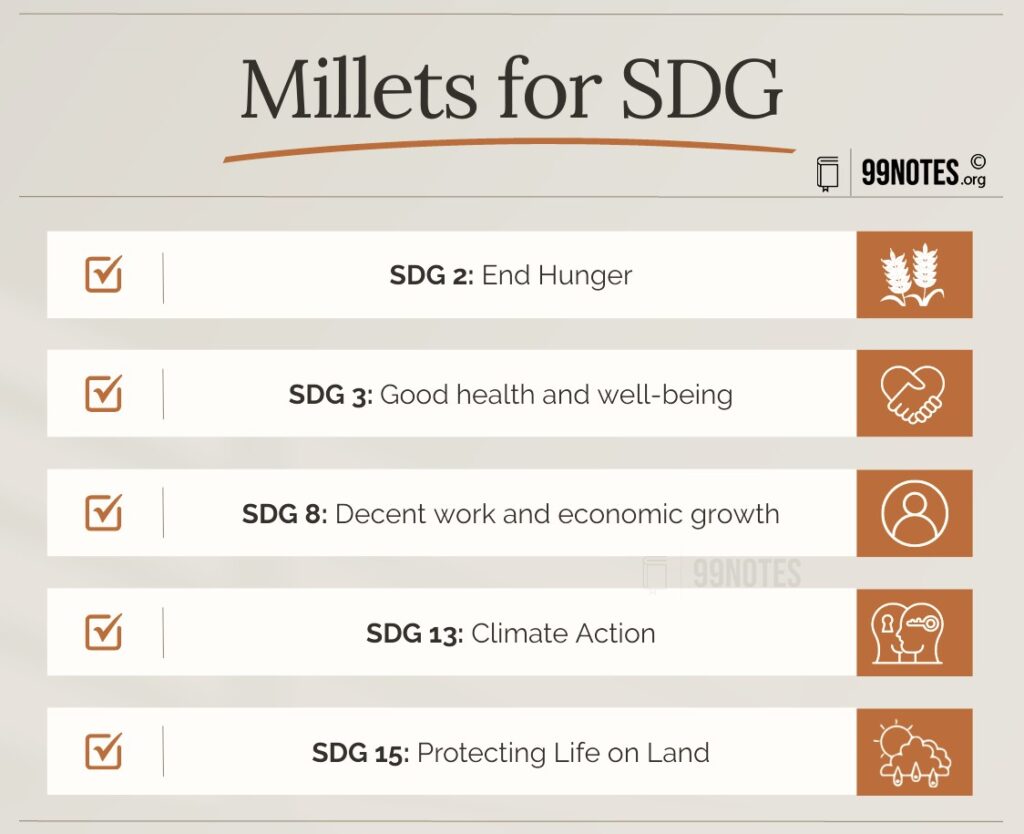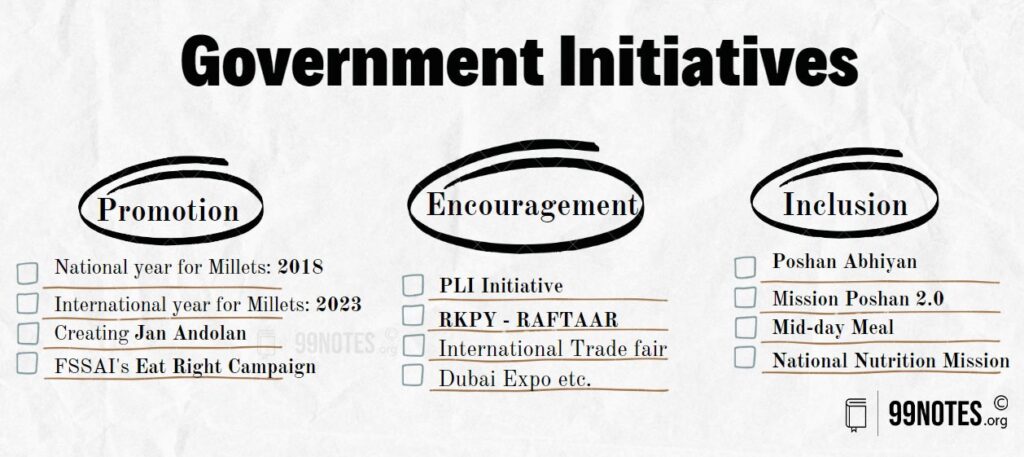Yojana Magazine January 2023- Detail Summary for UPSC Exam
Yojana Magazine January 2023 Summary: Millets
Millets
- Millets, popularly known as ‘Mota Anaj’ in Hindi, are a collective group of small-seeded annual grasses that are grown as grain crops, largely on marginal lands in dry areas of temperate, sub-tropical, and tropical regions.
- The majority of Millet is produced in Africa, followed by Asia. Country-wise, India, with 18 million tonnes in 2020-21, is the largest producer, followed by Niger and China.
- In India, millets can be categorised into Major millets, Minor millets and Pseudo categories.
| Major Millets | Sorghum (Jowar), Finger Millet (Ragi/Mandua), Pearl Millet (Bajra). |
| Minor Millets | Foxtail Millet (Kangani/Kakun), Proso Millet (Cheena), Kodo Millet, Barnyard Millet (Sawa/Sanwa/Jhangora), Little Millet (Kutki) |
| Pseudo Millets | Buckwheat (Kuttu) and Amaranth (Chaulai) |
Significance of Millets
I. Sustainable Agriculture (SDG 2: Sustainable Agriculture and End Hunger)
- Millets are resilient and grow in all kinds of soil and weather conditions while requiring minimum inputs.
- These are tolerant and resistant to diseases and pests and are more resilient to climate shocks than other cereals.
- Short growing season (60-100 days, as against 120-150 days for paddy/wheat) and
- Lower water requirement (350-500 mm versus 600-1,200 mm), and hence they can sustain in even draught-prone areas.
- Millets can be a way out of the problem of monoculture, which is harmful to both the land and our health.
- The low investment needed for production makes it a viable and sustainable income source for small and marginal farmers.
2. Climate Change and Environment (SDG 13: Climate Action & 15: Life on Land)
- Millets are C4 Carbon sequestrating crops contributing to the reduction of CO2 in the atmosphere.
- They also have low Carbon and water footprint.
- These crops demand less input of chemical fertilisers to grow, thus, making them bio-diverse and climate-smart crops.
3. Health (SDG 3: Good health and well-being)
- Millets are known to be a storehouse of nutrition as they are good sources of calcium, zinc, magnesium, phosphorus, copper, vitamin, iron, folate, carbohydrates, micronutrients and antioxidants.
- Due to their low Carbohydrate-fibre ratio, they can also be effective in many lifestyle diseases like Cardiac, diabetes mellitus, and some kinds of Cancer.
- Since millets are gluten-free and have a low glycaemic index (a comparitive ranking of carbohydrates in foods based on based on their impact on blood sugar levels), they can assist in addressing lifestyle and health issues including obesity and diabetes.
- Its high iron content can help fight the high prevalence of anaemia in women of reproductive age and infants.
4. Nutrition and Food Security (SDG 2: End Hunger)
- Millets are instrumental in ensuring locally available low-cost nutritious foods, particularly in arid areas.
- Processed millet products can be useful in diversifying the food basket under the public distribution system.
- Millet products can be used on a bigger scale in midday meals and Poshan schemes.
- Millet can be useful in dealing with food scarcity during difficult times like crop loss due to excess rain, drought and other climatic factors or external factors like war.
- Millets are deeply rooted in the culture and tradition of indigenous people and hence a very important crop from the food security point of view in areas where they are culturally relevant.
5. Livelihood (SDG 8: Decent work and economic growth)
- By promoting the consumption of millets and thereby increasing market opportunities, it can be an additional source of revenue.
- The resilient nature of the crop and low investment requirement makes it a viable alternative source of livelihood, especially for small and marginal farmers.
- Millets are also a good alternative for animal feed, which is a large and thriving market.
6. Commercial Potential (SDG 8: Decent work and Economic growth)
- With just 3% share in the global grain trade, there is a big potential in Millet production, processing and exports.
- According to an statistics, the Indian Council of Agricultural Research (ICAR), more than 1000 startups are currently working on coarse grains in the country.
- Millet products can provide a healthy and cheaper alternative in the age of packaged ready-to-eat food, which is usually unhealthy. It presents an opportunity for the export of value-added millet products.

Challenges
Although the Millets were part of the diet across the country, their significance has considerably reduced over the years due to a multitude of factors:
- Cultural preference: Wheat has gluten proteins which makes the dough more cohesive and elastic, but millets are gluten-free; hence, the easy availability of wheat led to its replacement.
- Increased Demand for Mill-processed Food: Even the rural population has started perceiving mill-processed rice and wheat as more aspirational.
- In many places, Millet production has been systematically discouraged. For example- the Kutki hatao soybean lagao (remove little Millet and grow Soyabean)campaign of the Madhya Pradesh government.
- The green revolution was disproportionately inclined in favour of wheat and rice.
- Poor market: There is an issue of very little profitability or demand, and supply chain networks are weak. Inconsistent demand and supply prevent its commercial viability.
- MSP Procurement: Due to the low demand for coarse grain in the public distribution system, the government is not very enthusiastic about procuring millets, even though they come under the MSP regime.
- Poor Research and Development: Due to little focus on Millet, there is less R&D in seeds, fertilisers and pesticides.
- Difficult post-harvest operations (threshing, drying, cleaning, packaging, storage, processing and transportation) add to the existing problems.
Government Initiatives
Promotion:
- The central government declared 2018 as the “National Year of Millets” to raise awareness about its health benefits and boost its production.
- On India’s initiative, the United Nations has declared the year 2023 as the international year of Millets (IYOM).
- The government aims to turn the Millet promotion into a Jan Andolan (People’s participation) by highlighting its nutritional benefits, showcasing it as a superfood and breaking the stigma of it being the “poor’s grain”.
- Millets are showcased in reputed events like the International trade fair, Dubai expo, Suraj Kund Mela, etc.
- FSSAI is also actively promoting Millets through its Eat Right campaign.
Inclusion in government’s nutrition schemes:
- Millets were included in the holistic nutrition scheme, POSHAN Abhiyan, in 2018 and Mission POSHAN 2.0 in 2021.
- Many states have Millet in the National Nutrition Mission and Mid-Day Meal Scheme.
Encouragement to Startups:
- Indian Institute of Millet Research has incubated over 250 startups under RKYP-RAFTAAR.
- The government is also enabling the startups to export promotions of value-added products like Ready to Eat and Ready to serve categories., by tweaking policies and providing Production linked incentives (PLI).
The government has evolved the ‘Seven Sutras’ (themes) in the run-up to the IYOM, which the concerned Ministry/Department will roll out to cover the various aspects related to Millet.

Way Forward
- Behavioural change is required to increase demand and make Millet a regular food option; therefore, mission-mode campaigning becomes important.
- Several minor millets are difficult to process; hence, they need to be supported to bring down their cost. Creating primary processing clusters at the farm level can help achieve economies of scale.
- Linking the crop with the market will encourage the farmers to grow millets.
- Value-added millet products, especially gluten-free can be developed for the export market. However, the processing units would need government support to meet the stringent regulations of North America and European markets.
- MSP Procurement: Government procurement of Millets needs to be increased to encourage farmers.
- Millets can be instrumental in increasing agricultural and dietary diversity, and for that that it needs the support of both individuals and institutions.



